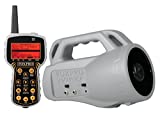Hunting coyote demands patience, cunning, an understanding of predatory instincts and usually the help of a call of some kind.
The coyote call market is huge and diverse – there are mouth calls, hand calls and electronic calls.
There are calls that mimic the vocalizations of the coyote themselves, allowing for a kind of ‘conversation’ in the language of coyote-sounds, and there are calls that mimic the sounds of wounded or distressed prey animals, which rely on the curiosity of the coyote themselves to bring them into your hunting grounds.
Ultimately, the best coyote calls are the ones that work most effectively for you on your particular coyote hunt. That’ll depend on the terrain, the climate, the time and effort you want to put into your calling, and other factors besides.
Here though, we’ve collected the best, most reliably effective calls on the market when you’re aiming to hunt the hunter.
In a hurry? Here’s our top pick.
In a hurry?
This is our Winner!
Our Pick
Best Coyote Calls - Comparison Table
Rank | Product Image | Product Name | Buy on Amazon |
|---|---|---|---|
1 | |||
2 | |||
3 | |||
4 | |||
5 |
Best Coyote Calls - Reviews
The FOXPRO Deadbone is an above-average entry level grab-and-go electronic coyote call that’s a natural built overachiever.
There are 15 calls pre-loaded onto the Deadbone – including some coyote vocalizations and some prey sounds.
Among those, you’ll find a coyote locator sound, howls and challenges from the female coyote, and even the noise of a coyote pup in distress to bring potential parents looking for the source of the sound.
Could you resist the sound of a crying baby?
Neither can they.
In among the prey sounds, you’ve got jackrabbit, cottontail, snowshoe hare, and baby cottontail.
Could you resist the smell of barbecue?
Neither can they, and the prey sounds are the audio equivalent of a sizzling grill.
There are calls on the market that give you hundreds of sounds to choose from, and they have their place on a coyote hunt, for sure, but the Deadbone is a good marker – if you can’t hunt coyote with this call, you probably shouldn’t hunt coyote.
The Deadbone gives you all – or at least most – of the basics you need, in a tough, rugged plastic composite shell made of something called ABS. It’s designed to be lightweight, rugged, weatherproof, and has even been tested in snow – often a killer environment for electronic calls.
One of the Deadbone’s neatest features is that it gives you the ability to play two of its 15 sounds at once, and it comes with a loud speaker, meaning you can use the call over substantial distances to bring in coyote.
It’s true that the Deadbone’s pre-loaded calls don’t include any male coyote sounds, and it’s also worth noting that this is not a programmable call, meaning you can’t download your own calls and sounds into it for a bespoke hunt.
But the Deadbone’s reliability, its simple uncomplicated list of useful sounds and its ruggedness even in circumstances which would lead other calls to give up the ghost, married to its entry level, grab-and-go price makes it our top pick.
Pros
Cons
Sometimes, you don’t need to re-invent the wheel, shove a bunch of batteries into it and strap it to a loudspeaker.
Sometimes, all you need is a simple idea, well delivered.
Welcome to the Primos Mouse Squeeze Call.
Based on the same principles as a squeaky dog toy, the Mouse Squeeze is a simple squeezable call which produces the sound of something small and furry in a state of distress.
That’s never going to call the coyote in from distant hills, but if there are any nearby, you can bet your last buck it will prick up their ears and make them come to investigate a free lunch or a tasty snack.
We could tell you it’s freezeproof for use on colder hunts, we could tell you it’s been tested for use in the toughest environments.
But the best thing we can tell you about the Mouse Squeeze is that it works.
Users report calling coyote into their kill-zone after just half an hour of squeaking with the Mouse Squeeze, because while coyotes are cunning predators, they don’t expect anything with the ability to kill them to sound tiny and squeaky and in distress.
That’s what lunch sounds like, and their natural predatory instincts are hard to fight in those circumstances.
Some users even claim the Mouse Squeeze takes some of the fun out of hunting coyote because of the certainty of the animals’ reaction to this kind of noise. It’s like Moby Dick being reduced to a ten-page pamphlet.
But if you want a simple coaxer for close calling coyote, it’s difficult to get better than the Primos Mouse Squeeze.
One word of warning for hunters with dogs – domestic dogs react in pretty much the same way as coyote, foxes and other predators in the dog family, so be sure to use your Mouse Squeeze responsibly. We have also reviewed the best predator hunting lights, so check them out as well.
Pros
Cons
The Johnny Stewart CYC-1 Coyote Dog Howler is a relatively simple call that produces coyote vocalizations from yelps and howls to the barks and whines.
Its adjustable band lets you change the pitch on your calls, giving you a variety of tones to use and letting you have a logical interaction with the coyote you’re hunting and proving the benefit of mouth calls over some of the more sophisticated electronic calls on the market.
It works by simply moving your mouth – the closer you put the end of the call’s reed to your mouth, the higher the pitch of the call you make, and the further away, the lower the tone goes, like a trombone.
That simplicity has made a name for the Dog Howler where more complicated calls, be they mouth calls or electronic ones, have stumbled.
The Dog Howler has grown popular as a first call for teaching new hunters the basics of sound and vocalization, and users report these new hunters are soon able to get realistic sounds out of the call. They also caution though that it’s not the best call to practice with indoors, as it’s loud and piercing, like a child’s first fiddle.
On top of which, there’s one big issue with the Dog Howler. Although it’s a fairly simple call to learn on, with even young hunters able to get the hang of it fairly quickly, it comes with no instructions, and even the great, all-knowing internet is pretty silent about exactly how you get the Dog Howler to do the things you want it to.
It’s less a grab-and-go call then, more of a get-outside-and-practice tool, at least until you start making recognizable sounds with it.
Those recognizable sounds aren’t restricted to just coyote either – with enough practice and the right band-adjustments, you can use the Dog Howler to call mountain lion, bear, bobcat and other predators.
That’s a lot of outside practice. Maybe think about taking it to some secluded area, so your neighbors don’t declare open season on whoever’s making that racket.
That said, once you’ve mastered the Dog Howler, it can give you good results for coyote hunting without any of the high-tech luggage of an electric call. Check out our review of the best coyote hunting lights for more top picks.
Pros
Cons
Another entry-level electronic call, the Primos Dogg Trap is a direct alternative to the Deadbone, and an effective electronic coyote call for under a hundred dollars.
It’s claimed the Dogg Trapp claims to allow you to make two sounds at the same time, but some users say this isn’t exactly true.
While listing only ten sounds pre-loaded in its brain, the Dogg Trap also contains two full pre-programmed hunts by Randy Anderson, and users say the ‘two sounds at once’ capacity of the Dogg Trap extends only as far as sounds on those pre-programmed hunts that happen to have been recorded at the same time.
That said, the Dogg Trap does have some distinct advantages over the Deadbone. It’s a truly programmable call, meaning you can sequence the sounds in the call, and load in your own additional sounds as MP3 files, to vary and broaden the scope of your hunt and its communication.
In flat areas, the Dogg Trap has a voice that can call coyote effectively at anything between 500 and 700 yards, and with a set of extendable legs, you can use it in most areas where you find coyote.
As with the ‘two sounds at once’ claim, there are other areas where the company’s claim and the general user experience don’t tally.
Primos claims the Dogg Trap has a remote range of around 50 yards, whereas users have repeatedly reported the actual remote range is about half that distance – which is important to know if you’re aiming to buy a call with a longer remote range.
The Dogg Trap is a respectable call with a wider potential than the Deadbone over time, thanks to its programmable sound bank, but it places in the middle of our list for uncertainty over some of its capabilities, differences between company claims and user experiences, and because of the Deadbone’s ruggedly can-do, grab-and-go feel. Before you leave, why not check out our best coyote electronic calls guide - and see what our top picks are.
Pros
Cons
The FOXPRO Inferno is the grown-up, programmable electronic coyote call which the Deadbone, with its basic, straightforward clutch of calls never really tries to be.
It’s worth noting that the Inferno is double the price of the grab-and-go Deadbone, which is certainly a factor in why the programmable call doesn’t rank higher in our list.
But all the extra money really means is that we expect the Inferno to do twice as much as the Deadbone to earn its place in our hunting kit.
Whether it does twice as much is debatable, but it certainly does more.
The Inferno comes with 75 calls pre-loaded, and gives you the space to add 125 more, for a personalized bank of up to 200 sounds on any hunt, should you find you need anywhere near that many.
When you have that many sounds to choose from, what you need most in the world is an easy way to find the ones you need. 200 sounds stored randomly is like an unsorted tool box – the chances of laying your hand on the precise wrench you need at a moment’s notice are slim to none.
Fortunately, the Inferno has two innovations to make that big library viable.
Firstly, you can categorize your sounds into folders – Male coyote vocalizations, female coyote vocalizations, prey sounds, etc. That means when you’re out on a hunt, you’re not scrolling through 200 sounds when the pressure’s on, but can locate the ones you need easily.
And secondly, the remote for the call has a reasonably screen and chunky buttons, so you’re not squinting and fiddling with tiny controls when you’re out in the wild. That might sound like quibbling, but it can make a big difference when you just need things to work right.
To build that big library of sounds, you can plug the Inferno into a computer with a simple USB – another simple solution that makes the Inferno easy to use despite its big sound library.
Built out of FOXPRO’s rugged ABS material, the Inferno weighs less than 1.5 pounds, making it a lightweight call that can add enormous value and scope to your hunt.
The Inferno also comes with a tricksy feature called FOXBANG. FOXBANG is a system that lets you automatically switch to an assignable function after you fire your shot. That means hands-free sound changing.
Before you all rush to click the ‘buy’ button on the Inferno though, some users have complained about the actual delivery experience through the mail, reporting parts missing or damaged.
It’s also worth noting that while the Inferno lets you access a library of free sounds from which you can download your favorites, some users have claimed the best and most useful sounds in this library are not freely available at all, but available to buy at additional cost.
That said, if you’re one of the very many who receive your Inferno as it should be, the thought that’s gone into creating a highly effective and usable electronic coyote call mean it should give you years of happy hunting.
Pros
Cons
Best Coyote Calls - Buyers Guide
When you set out to hunt coyote, you need every trick you can lay your hands on, because coyote hunting depends on outwitting one of nature’s most cunning predators. But a crowded market means there are questions to ask before you click the ‘buy’ button.
Electronic or mouth calls?
That depends on whether you want to put the time into learning the vocalizations of coyote calling. It’s not easy, so the attraction of an electronic call is that you bypass that time and can skip to the hunting part.
On the other hand, mouth calls are smaller, more adaptive and allow you to react faster and more naturally in the moment. Ask yourself what’s more important to you – ease or flexibility?
Different Sounds?
If buying electronic, how many sounds do you actually need? How complex is your hunting environment? Do you need a bank of 200 sounds, or will a handful do the job you need them to.
Don’t pay for capacity you’re never going to need.
Features
If buying mouth calls, read the fine print, and compare their specialities with your hunting environment.
If you regularly hunt in freezing temperatures, or waterlogged terrain, make sure you choose calls that aren’t going to freeze up on you or let in water. Match your call both to your type of hunting and the terrain in which you do it.
Frequently Asked Questions
What should I look for in a coyote call?
Ultimately, something that helps you kill coyotes. That’s an individual thing. Some hunters are happy with close calling through a simple prey call. Others want a bank of 200 pre-programmed sounds to seal the deal.
What you’re looking for is whatever best bridges the gap between your hunting style and the coyote.
How much should I pay for a coyote call?
Again, that’s up to you – your budget and what you want the call to do for you. You need your call to give you value for money. The more money you spend, the more it has to deliver to your hunting experience.
Bottom line, it has to help you hunt coyote, reliably, every time you go out to hunt. If it’s not going to do that, then any amount is too much. Match your call choice to your hunting style though and you should get more value from the calls you choose.







